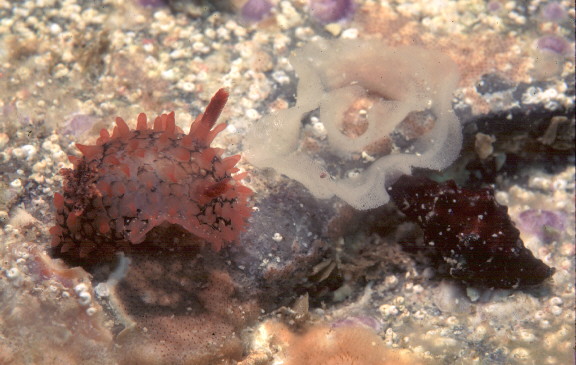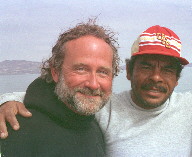
Acanthodoris pina
Acanthodoris pina Marcus & Marcus, 1967
This black and red acanthodorid is endemic to the northern Gulf of California. The original reports of this species are from Puerto Penasco (Sonora), and several northern localities from the Gulf coast of Baja California (Bahia Percebu, Punta Diggs, Puertecitos, and Bahia San Luis Gonzaga.). Our records of this species from Bahia de los Angeles represent a slight southerly range extension. It has not been found commonly at Bahia de los Angeles.
The 10-15 mm long animal has a black dorsum with numerous large reddish and small white papillae. The rhinophores and gills are reddish brown in color; there is a red stripe around the margin of the foot, the frontal veil, and the notum.
James Lance named Acanthodoris stohleri based on over 60 specimens; his holotype specimen had been collected by Gale Sphon at Bahia San Luis Gonzaga. The Marcuses named A. pina based on only 3 specimens collected at Puerto Penasco by researchers from the University of Arizona. However, Marcus & Marcus ' paper was published on 22 December 1967; James Lance's was published 8 January 1968. By the rules of priority, the 3 species Lance named became synonyms as soon as they were published.
Lance published some interesting biological information about this species in his original description. Although he did not illustrate the egg mass, he wrote the following: "Nidosome...assumes the shape of a white ribbon, loosely coiled counterclockwise, attached by one edge to the substratum. The attached and free margins are of equal length resulting in erect, vertical sides. In general shape it resembles that of Acanthodoris nanaimoensis as figured by Hurst (1967) except, a curiously , her illustration depicts a dextrally-oriented spiral.
"Of the nine nidsomes deposited, the simplest consisted of a single convolution, the largest of approximately two whorls. The pure white egg capsules contained a single egg each were deposited in vertical rows within the colorless, jelly-like matrix. A typical nidosome measured 9 mm at its greatest diameter and 2.8 mm in height. No attempt was made to observe embryological development."
We here present the first published illustration of the egg mass of Acanthodoris pina.
In Bahia de los Angeles, specimens of this species have been collected from Punta la Gringa, and from the entrance to Puerto Don Juan.
We have been told that Terry Gosliner does not have a photograph of this species, and may not yet have seen it alive. This doesn't bother us, because he has seen some species that we have not seen!
Text courtesy of:

Assoc. Prof. |
For those of you interested in the photographic background information of the images, the following may be of interest!
Camera System: Tussey T-300 underwater housing with FM2/Nikon 60mm lens.
Strobe: Ikelite Ai
Film: Kodak ASA 100 Print Film
Site: Bahia de los Angeles, Baja California
Photo Editing: PhotoStyler 2.0 on 486 DX-2 33 mhz/ 64 megs RAM
